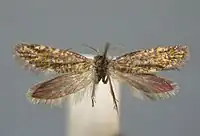| Dyseriocrania subpurpurella | |
|---|---|
.jpg.webp) | |
.jpg.webp) | |
| Scientific classification | |
| Domain: | Eukaryota |
| Kingdom: | Animalia |
| Phylum: | Arthropoda |
| Class: | Insecta |
| Order: | Lepidoptera |
| Family: | Eriocraniidae |
| Genus: | Dyseriocrania |
| Species: | D. subpurpurella |
| Binomial name | |
| Dyseriocrania subpurpurella | |
| Synonyms | |
|
List
| |
Dyseriocrania subpurpurella is a diurnal moth from the family Eriocraniidae, found in most of Europe. The moth was first named by the English entomologist, Adrian Hardy Haworth in 1828.



Description
The wingspan of the moth ranges from 9–14 mm. The wings are metallic gold with sapphire-blue and ruby-red dots (strigulae) and an indistinct obscurely paler dorsal spot before tornus. The hindwings are brassy-grey, posteriorly purplish-tinged and like the forewings have grey cilia. The head is ochreous-grey-whitish mixed with dark fuscous.[2] The moths are on the wing in April and May, fly on sunny days and come to light. On dull days they rest on the trunks and branches of oak. They do not feed.[3][4][5]
- Sub-species
- Form fastuosella – is a more richly marked sub-species with purple spots or striations.[3]
- Ovum
Eggs are laid within the leaf tissue of oak (Quercus species), approximately 2 mm from the leaf margin.[6]
- Larva
The caterpillar is whitish with a pale-brown head.[5] It lives inside the leaves of Quercus (oak) species making a blotch mine with ″spaghetti like″ frass from May to July. Initially the mine is a narrow corridor circa 5 mm wide and is mostly filled with granular frass. The corridor (or gallery) abruptly widens into a large. full depth. dirty-whitish blotch which is on the leaf margin. The frass within the blotch is in long threads. If several eggs are laid on the same leaf, the mines join together with several larvae in the enlarged blotch. The mine is similar to that of the beetle, Orchestes pilosus, but the sawfly's mine is small and darker when fully formed.[6][7][8]
Host plants include Turkey oak (Quercus cerris), sessile oak (Quercus petraea), downy oak (Quercus pubescens), Pyrenean oak (Quercus pyrenaica), pedunculate oak (Quercus robur), northern red oak (Quercus rubra) and sweet chestnut (Castanea sativa).[6]
- Pupa
The larva forms a tough silken cocoon in the soil, which can be found from July to April.[7][5]
Distribution
The moth has been recorded from most European countries except Bulgaria, Croatia, Cyprus, Faroe Islands, Iceland, Malta and Slovenia.[1]
Etymology
The moth was originally named Tinea subpurpurella by Adrian Haworth, from a specimen found in Coomb Wood [sic], England.[5] Originally allocated by Haworth to the genus Tinea, which was originally raised by the Swedish taxonomist Carl Linnaeus and means "a gnawing worm". Until recently, the moth was in the genus Eriocrania, which was raised by Philipp Christoph Zeller in 1851. Erion means wool and kranion means the upper part of the head, which refers to the hair-scales on the top of the head. The moth is now in the genus Dyseriocrania. The specific name refers to the purple colouration of the forewing on part of the wing.[9]
References
- 1 2 "Dyseriocrania subpurpurella (Haworth, 1828)". Fauna Europaea. Retrieved 4 January 2022.
- ↑ Meyrick, Edward (1895). A Handbook of British Lepidoptera. Macmillan: London. Retrieved 31 December 2021.
- 1 2 Kimber, Ian. "Dyseriocrania subpurpurella (Haworth, 1828)". UKmoths. Retrieved 31 December 2021.
- ↑ Manley, Chris (2021). British & Irish Moths. A Photographic Guide (Third ed.). London: Bloomsbury. p. 20.
- 1 2 3 4 Heath, John (1983). Eriocraniidae. In The Moths and Butterflies of Great Britain and Ireland. Volume 1. Colchester: Harley Books. pp. 156–160. ISBN 0-946589-15-1.
- 1 2 3 Ellis, W N. "Dyseriocrania subpurpurella (Haworth, 1828) common oak purple". Plant Parasites of Europe. Retrieved 6 January 2022.
- 1 2 Emmet, A M, ed. (1988). A Field Guide to the Smaller British Lepidoptera (Second ed.). London: British Entomological and Natural History Society. p. 16.
- ↑ "2.001 Dyseriocrania subpurpurella (Haworth, 1828)". British leafminers. Retrieved 30 December 2021.
- ↑ Emmet, A Maitland (1991). The Scientific Names of the British Lepidoptera. Their history and meaning. Colchester: Harley Books. pp. 42 & 59. ISBN 0-946589-35-6.
- Meyrick, E., 1895 A Handbook of British Lepidoptera MacMillan, London pdf
 This article incorporates text from this source, which is in the public domain. Keys and description page 805
This article incorporates text from this source, which is in the public domain. Keys and description page 805
External links
- Beccaloni, G.; Scoble, M.; Kitching, I.; Simonsen, T.; Robinson, G.; Pitkin, B.; Hine, A.; Lyal, C., eds. (2003). "Dyseriocrania subpurpurella". The Global Lepidoptera Names Index. Natural History Museum.
- Swedish Moths
- Eriocrania subpurpurella at Naturhistoriska riksmuseet